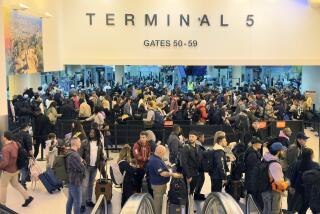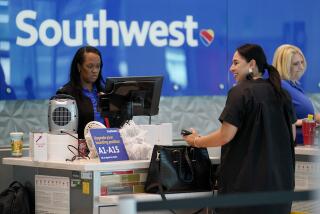Your Frequent-Flyer Miles Fly Farther in the Off-Season
- Share via
In the post-holiday world of bargain hunting, there is one bargain that many travelers overlook--using frequent-flyer mileage awards for off-season travel.
During less heavily traveled seasons, known as “off-peak,” some airlines offer deals in which members of frequent-flier awards programs “pay” fewer mileage points for travel. These off-peak offers thus give travelers an opportunity to stretch the mileage they’ve earned. For example, if an airline typically requires 50,000 miles to fly economy class from the U.S. to Europe during its regular season, it might offer the same ticket for 35,000 miles during the winter months.
“Most people don’t know enough about [the off-peak programs],” says Randy Petersen, editor of InsideFlyer, a Colorado-based publication that keeps track of industry award programs. “It’s a great way to save a lot of money.”
Indeed, it can be particularly useful for people who watched their mileage accounts dwindle when some of their miles expired this past year. Petersen estimates that about 20 billion frequent-flier miles expired at the end of December, which means people have fewer miles to plan their travel with.
“For the person who is flexible, it would definitely stretch their miles to go off-peak,” says Mary Alice Crosson, a travel agent with Mutual Travel in Seattle.
People who fly during off-peak seasons on airlines that have the off-peak deals can save as much as 40% on the miles they use to get to where they’re going, depending on the program. Not all the airlines have off-peak awards, however, and some highly popular destinations, such as Hawaii, are not included.
Petersen says international travel is a particularly good strategy because savings can be substantial. It can broaden horizons for skiers, for example. “Don’t waste 25,000 miles going in the U.S.--go skiing in Europe for 30,000 miles. You can do it if you look for off-peak awards.”
Most airlines consider the off-season period from October through April (excluding the holiday period). The exact dates vary by program.
For example, between Oct. 1 and April 30, American Airlines lets you fly coach between North America and Tokyo for 50,000 miles, a 15,000-mile savings over the regular award level. A coach-class ticket between the U.S. and Asia or the South Pacific on Northwest Airlines will cost 45,000 miles between Sept. 15 and Dec. 14; you would have to use up 10,000 more miles during peak season.
American lets you fly coach to Europe for 40,000 miles off season (Oct. 1-April 30), a 20,000-mile savings over the regular award requirement. British Airways and USAir offer the same deal as American. And on Northwest, it only takes 35,000 miles for a coach-class ticket to Europe, a 15,000-mile savings for flying between Jan. 15 and March 14.
Off-peak for a U.S. destination on Northwest is Sept. 1 through Nov. 14, and costs 20,000 miles instead of 25,000 miles (excluding Hawaii).
Neither United nor Southwest offers off-peak travel savings.
Delta offers a mileage “stretcher” award, but it can be used only for a pair of tickets, not for a single, according to Delta spokesman Clay McConnell. Two passengers can fly to Europe for 70,000 miles if they fly between Nov. 1 and Feb. 28, a trip that would cost 100,000 miles during the regular season. Two can fly off-season to Asia for 90,000 miles, a trip that would normally cost 120,000 miles.
Although traveling off-peak can save miles, it may require extra planning. The further ahead you can plan your trip, and the more flexible you are, the better, advises Jim Faulkner, a spokesman for Northwest. The airline doesn’t change the number of seats designated for awards during the off-peak season, Faulker says, but it can still take some jockeying to find a seat, depending on demand.
Petersen of InsideFlyer recommends trying to book off-peak awards 60 to 100 days ahead. If you’re willing to use connecting flights and layovers, it will be even easier to find seats, he said. “Direct flights fill up first.”
As with any awards travel, it helps if you can be flexible with your departure day, but Petersen warns that travelers make sure they know when the off-peak award applies. If you end up departing or leaving on a day that falls outside the designated time frame, you can be docked for the full mileage requirement.
Being flexible in your destination can also help. If you can’t fly into Madrid, a popular winter destination, for example, try flying to another European city and renting a car. Since car rental rates are also often lower off-season, you may still end up with a considerable savings.
Of course, off-peak seasons are usually off-peak for a reason. They fall during the winter months, when fewer people like to travel because bad weather.
But there are those who don’t mind the chill. As travel agent Crosson points out “If you go to Europe for the museums and concerts, all that is exactly the same [during off season]. [And] the hotel rates are less, and there are fewer people.”
“I was at Versailles in February once and there were maybe 15 people in our group,” she said. “During the summer months there are hordes. We thought it was perfectly wonderful.
“Of course, the gardens didn’t look the way they would have in the summer,” she added. “So there are trade-offs.”
*
Christopher Reynolds is on assignment.
More to Read
Sign up for The Wild
We’ll help you find the best places to hike, bike and run, as well as the perfect silent spots for meditation and yoga.
You may occasionally receive promotional content from the Los Angeles Times.






